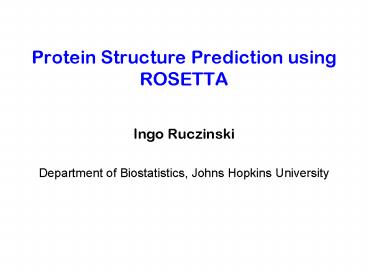Protein Structure Prediction using ROSETTA - PowerPoint PPT Presentation
1 / 42
Title:
Protein Structure Prediction using ROSETTA
Description:
Protein folding is concerned with the process of the protein taking its three ... Charlie Strauss. Harvard University. Kim Simons. UC Santa Cruz. Carol Rohl ... – PowerPoint PPT presentation
Number of Views:242
Avg rating:3.0/5.0
Title: Protein Structure Prediction using ROSETTA
1
Protein Structure Prediction using ROSETTA
- Ingo Ruczinski
- Department of Biostatistics, Johns Hopkins
University
2
Protein Folding vs Structure Prediction
- Protein folding is concerned with the process of
the protein taking its three dimensional shape.
The role of statistics is usually to support or
discredit some hypothesis based on physical
principles. - Protein structure prediction is solely concerned
with the 3D structure of the protein, using
theoretical and empirical means to get to the end
result.
This presentation is about the latter.
3
Flavors of Structure Prediction
- Homology modeling,
- Fold recognition (threading),
- Ab initio (de novo, new folds) methods.
ROSETTA is mainly an ab initio structure
prediction algorithm, although various parts of
it can be used for other purposes as well (such
as homology modeling).
4
Ab Initio Methods
- Ab initio From the beginning.
- Assumption 1 All the information about the
structure of a protein is contained in its
sequence of amino acids. - Assumption 2 The structure that a (globular)
protein folds into is the structure with the
lowest free energy. - Finding native-like conformations require
- - A scoring function (potential).
- - A search strategy.
5
Rosetta
- The scoring function is a model generated using
various contributions. It has a sequence
dependent part (including for example a term for
hydrophobic burial), and a sequence independent
part (including for example a term for
strand-strand packing). - The search is carried out using simulated
annealing. The move set is defined by a fragment
library for each three and nine residue segment
of the chain. The fragments are extracted from
observed structures in the PDB.
6
The Humble Beginnings
- Kim Simons and David Baker tackle ab initio
structure prediction (1995/96). - A bit later, Charles Kooperberg and Ingo
Ruczinski join the project. - Two publications appear
- Simons et al (1997) Assembly of protein tertiary
structures from fragments with similar local
sequences using simulated annealing and Bayesian
scoring functions, JMB 268, pp 209-25. - Simons et al (1999) Improved recognition of
native-like protein structures using a
combination of sequence-dependent and
sequence-independent features of proteins,
Proteins 34, pp 82-95. - With the help of Richard Bonneau and Chris
Bystroff, Rosetta is used for the first time on
unknown targets in CASP3 (1998).
7
The Rosetta Scoring Function
8
The Sequence Dependent Term
9
The Sequence Dependent Term
10
(No Transcript)
11
Hydrophobic Burial
12
Residue Pair Interaction
13
The Sequence Independent Term
14
Strand Packing Helps!
Estimated f-q distribution
15
Sheer Angles Help not!
16
The Model
17
Parameter Estimation
18
Parameter Estimation
19
Parameter Estimation
20
Parameter Estimation
21
Fragment Selection
22
(No Transcript)
23
Validation Data Set
24
3D Clustering
25
3D Clustering
26
3D Clustering in CASP3
27
CASP3 Protocol
- Construct a multiple sequence alignment from
f-blast. - Edit the multiple sequence alignment.
- Identify the ab initio targets from the sequence.
- Search the literature for biological and
functional information. - Generate 1200 structures, each the result of
100,000 cycles. - Analyze the top 50 or so structures by an
all-atom scoring function (also using clustering
data). - Rank the top 5 structures according to
protein-like appearance and/or expectations from
the literature.
28
CASP3 Predictions
29
CASP3 Results
30
Contact Order
31
Contact Order
32
Clustering and Contact Order
33
Decoy Enrichment in CASP4
34
A Filter for Bad b-Sheets
Many decoys do not have proper sheets. Filtering
those out seems to enhance the rmsd distribution
in the decoy set. Bad features we see in decoys
include
- No strands,
- Single strands,
- Too many neighbours,
- Single strand in sheets,
- Bad dot-product,
- False handedness,
- False sheet type (barrel),
35
A Filter for Bad b-Sheets
36
A Filter for Bad b-Sheets
37
A Filter for Bad b-Sheets
38
Rosetta in CASP4
39
(No Transcript)
40
Applications and Other Uses of Rosetta
- Other uses of Rosetta
- Homology modeling.
- Rosetta NMR.
- Protein interactions (docking).
- Applications of Rosetta
- Functional annotation of genes.
- Novel protein design.
41
Collaborators
Collaborators People who I troubled way more
than I should have.
42
Rosetta Developers































